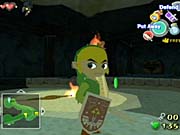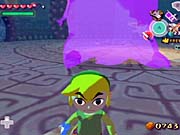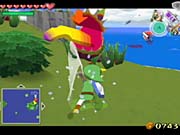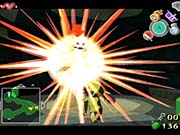While Nintendo has a wide array of classic characters in its repertoire, The Legend of Zelda has become the company's flagship series. The last big Zelda game, The Ocarina of Time, basically reinvented the series for the polygonal generation, retaining the basic elements that have made the series great while unveiling new standards, such as the Z-trigger-based lock-on targeting system that made combat easier to manage and more exciting. The newest installment in the series is finally upon us in the form of The Legend of Zelda: The Wind Waker, which sticks quite close to the blueprint drawn up by 1998's The Ocarina of Time. But what truly makes The Wind Waker a landmark event and sets it apart from most other games on the market today is its high level of polish.

At the start, The Wind Waker's story feels really separate from any of the previous Zelda games, though it ends up tying into the rest of the series pretty well. The game opens on the appropriately named Outset Island, where you live with your sister and grandmother. It's your character's birthday, and he's reached the age when it's customary for boys to wear green clothing that honors The Ocarina of Time version of Link, who is now known as the "hero of time" in the legends that speak of his Ocarina exploits. Shortly after you wake up and don your classical Legend of Zelda garb, all hell breaks loose in the form of a giant bird carrying a small girl toward the island, with a pirate ship giving chase and firing cannonballs. Eventually, the bird makes off with your sister, and you team up with the pirates to follow the bird and get your sister back. As luck would have it, this series of events grows into something much larger as you proceed, and as you'd expect, the very fate of the world hangs in the balance by the time you reach the game's final confrontation.
While The Wind Waker does have its own twists and turns--much of the gameplay involves you sailing around the world in a talking boat known as the King of Red Lions, for example--the gameplay is very similar to that of The Ocarina of Time. The control scheme is nearly identical, using the GameCube controller's L trigger for lock-on targeting and the Z, X, and Y buttons for any inventory items you choose to assign there. The combat is also very similar, though there is a new counter move that lets you easily sidestep or leap over incoming attacks and strike at a foe's back. The combat in The Ocarina of Time worked really well, so it's no surprise that the combat in The Wind Waker also works very well.
Like in other Zelda games, progressing in The Wind Waker is tied to having the right items in your inventory. More often than not, you'll earn your new items in the game's dungeons and then go on to face a boss battle that requires you to use your new item properly to emerge victorious. The classic items that we've seen introduced over the course of the series return here, including power bracelets, bombs, the hookshot, the boomerang, multiple types of arrows, empty bottles, and, of course, the master sword. The returning items behave in a pretty standard fashion, though the boomerang has been upgraded this time around to target up to five enemies or objects at once. One or two puzzles in the game require you to use this new functionality. New this time around are items like the grappling hook, which can be used to steal items from enemies or swing from place to place using specially marked targets. The deku leaf can be used like a hang glider or parachute of sorts, and it comes in handy when you need to cross large gaps. You can also use the leaf to blow gusts of wind at objects and enemies. The wind waker itself is a conductor's baton that has the power to control the wind. Much like with Link's ocarina, you'll learn songs throughout the game that have various magic effects. One warps you from place to place, another turns night into day, and yet another lets you control the direction of the wind, which, as it turns out, is very important indeed.

The world of The Wind Waker consists of a large collection of islands. Once you've completed the first few portions of the game, you're given access to the King of Red Lions and the watery overworld. Your talking boat will basically guide you through the game, and you'll use a sail, a sea chart, and the wind waker's ability to change the direction of the wind to move from island to island. While the world is quite large and full of all sorts of little side quests, the game is also very good about marking sectors and islands on your chart when they become important to your progression, so getting lost or stuck in the game's large overworld is actually pretty difficult. The sailing can be a bit much at times, but once you've learned a warp song for your wind waker, you can skip around to the more important locations with ease. Once you set foot on land, you'll find a variety of locales, including towns, fortresses, fairy caves, a ghost ship, and dungeons.
While The Wind Waker has a lot more overworld and town work than some of the previous games in the series, you'll definitely be spending a fair amount of time in the game's dungeons. None of them ever get as devious as The Ocarina of Time's water temple, but these portions of the game definitely have their own sets of challenges. The game's different dungeons have different themes, such as fire, ice, plants, and wind. Two of the game's later dungeons throw in an extra, Ico-like twist by forcing you to bring another character along with you. These helper characters have abilities of their own, which come into play when solving puzzles in those dungeons.
While The Legend of Zelda games have never been overly difficult, The Wind Waker seems to be easier than previous entries in the series. Most of the game's in-dungeon puzzles are really straightforward, and the game's bosses rarely put up a terribly threatening fight. Even the game's multistage final boss battle is only marginally difficult. Players already familiar with The Ocarina of Time combat and control system should be able to breeze through the game without having to go out of their way to acquire extra bottles for fairies or medicine or find the game's numerous hidden heart pieces. Eager Zelda fans who pre-ordered the game should have already been brushing up on this fighting system, thanks to Nintendo's Zelda preorder disc offer, which includes both the original Ocarina of Time and a more-challenging "master quest" version of Ocarina. Both of these hold up well, considering how much time has passed since their original release, but the Wind Waker is good enough to justify the entire purchase on its own.

The Wind Waker makes fantastic use of the GameCube's ability to link up to the Game Boy Advance. In the game, you'll acquire an item called the Tingle tuner, which essentially looks like a Game Boy Advance with an antenna sticking out of it. With it, you can call upon the fairy wannabe Tingle, who appears on the GBA screen along with a map of your surroundings. As you move around, Tingle will occasionally give you hints about dungeon puzzles, and his map of the sea is helpful for finding islands before you've properly charted a quadrant. Tingle can also heal you, restore your magic, drop a bomb anywhere you put his cursor, and give you the ability to fly for short periods of time. All this extra item- and power-up-based help comes at the cost of a handful of rupees, and it's never actually required. The entire Tingle tuner portion of the game seems to have been designed to allow parents to help young children through the game, as his hints and items can be used to make the game even easier than it already is. However, Tingle's bonuses are disabled during boss fights and other important encounters, limiting his effectiveness.
All told, the game can be completed in 15 to 20 hours, though considering all the extra heart pieces, treasure maps, and other little optional endeavors in the game, that number can increase fairly dramatically. The game's quest starts out in a very brisk manner, quickly moving you from dungeon to dungeon without delay. The game's final third, however, requires you to collect a series of items before you can gain entry to the game's final sequence. Collecting these items isn't difficult, but the focus on sailing, rupee collecting, and dredging up items from the bottom of the sea is pretty tedious. While this portion of the game has actually been shortened up a bit since the Japanese release, it still feels like it was put in the game merely to pad it out to an acceptable length. Thankfully, the game gets back on track after this portion is completed, and the game's final confrontation puts a nice new twist on the classic Zelda boss fight.
Much has been said about The Wind Waker's cartoonlike, cel-shaded look, which was initially met with quite a bit of skepticism when it debuted some time ago. That skepticism is completely unfounded, though, as this new entry in the series looks absolutely amazing. What seems like a relatively simple look on the surface is revealed to be quite complex pretty early on, as the game begins to show off some of its facial animation techniques. The game's characters are extremely expressive in their motion and appearance, and this adds emotional weight to the game's text-based story line. There are lots of great little touches to the game's look. The game's focus on wind translates into grass that blows naturally, sails that fill with wind when you've pointed them in the right direction, and swirling gusts of wind that clue you in to the wind's direction and force--something that actually factors into the gameplay on more than one occasion. Artistically, The Wind Waker is nearly unmatched, on the GameCube or on any other platform.
But the game is no technical slouch, either. It runs at a pretty consistent frame rate, allows you to clearly see far-off objects and islands with ease, and makes great use of various lighting effects for things like torches and other underground light sources. About the only noticeable bit of weirdness in the game's visuals is some occasional dithering or color banding when you're out on the open sea at night, but even that is relatively rare and stands out only if you're specifically looking for it. It's also worth noting that the game features progressive scan support for those with higher-end displays.

The Wind Waker's music is a collection of fantastic tunes. Some of it is completely new, some of it qualifies as a remix of older (usually The Ocarina of Time) music, and some of it is music that sounds reminiscent enough of older Zelda music to remind you of specific passages in previous compositions. Regardless of the source, the music all comes together very, very nicely. There isn't any real speech in the game, though most major characters make a series of noises when you speak to them. Link himself has the same style of yelps, shouts, and screams that you've heard in previous Zelda games. While the noises do work fairly well, hearing the same handful of voice clips again and again in combat does tend to wear on you a little bit. The game's sound effects and other audio elements are nicely done, and, depending on your surroundings, they occasionally pick up a little echo. For players with above-average audio configurations, the game makes pretty good use of its Dolby Pro Logic II support.
While some may be a little put off by the late-game item fetching and the game's easy puzzles and boss battles, The Wind Waker is nonetheless a strong achievement in every way, from its stunning graphical presentation to its tight control and interesting story line. It may not have fallen too far from the tree Nintendo planted back in 1998, but the way it refines one of the polygonal generation's most important games makes The Wind Waker every bit as much of a must-own game as The Ocarina of Time was before it.